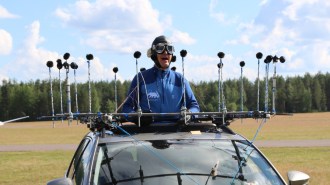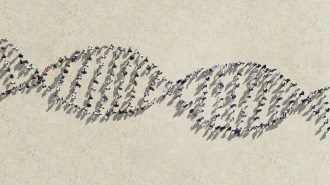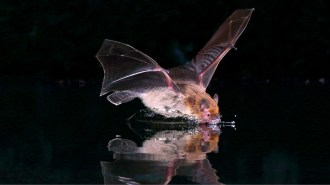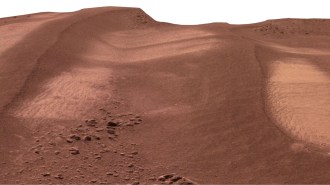News
-
 Paleontology
Paleontology‘Thunder beast’ fossils show how some mammals might have gotten big
Rhinolike mammals called brontotheres repeatedly evolved into bigger and smaller species, a fossil analysis shows. The bigger ones won out over time.
By Elise Cutts -
 Animals
AnimalsWhy some hammerhead sharks seem to ‘hold their breath’ during dives
Scalloped hammerhead sharks in Hawaii seem to limit the use of their gills during deep dives to prevent losing heat to their surroundings.
By Freda Kreier -
 Physics
PhysicsScience explains why shouting into the wind seems futile
Sending a sound upwind, against the flow of air, makes the sound louder due to an acoustical effect called convective amplification. Sound sent downwind is quieter.
-
 Tech
TechA flower-shaped soft robot could make brain monitoring less invasive
Once inserted in the skull, the device unfurls flexible sensors that can monitor the brain's electrical activity less invasively than current methods.
By Bob Hirshon -
 Life
LifeThe new human pangenome could help unveil the biology of everyone
The deciphered DNA includes never-before-explored parts of the genome and better represents the genetic diversity of all humans.
-
 Life
LifeAncient giant eruptions may have seeded nitrogen needed for life
A new study bolsters the idea that on the young Earth volcanic lightning may have provided some materials that made it possible for life to emerge.
By Bas den Hond -
 Health & Medicine
Health & MedicineSan Francisco airport will monitor plane waste for COVID-19 variants
The airport, working with the CDC and a biotech company, will be the first in the United States to regularly test plane sewage.
-
 Planetary Science
Planetary ScienceWhy you shouldn’t use magnets when looking for meteorites
A popular tool for identifying meteorites can overwrite records of magnetic fields stored within the space rocks.
-
 Astronomy
AstronomyThe James Webb telescope revealed surprise asteroids in the Fomalhaut star system
New images of Fomalhaut confirm that an alleged planet is probably just dust while also revealing a new asteroid belt and a “Great Dust Cloud.”
-
 Animals
AnimalsPregnancy may hamper bats’ ability to ‘see’ in the dark
Tiny Kuhl’s pipistrelle bats make fewer calls when pregnant, which may make it more difficult to hunt prey, lab tests hint.
By Freda Kreier -
 Space
SpaceSalty water may have flowed near Mars’ equator as recently as 400,000 years ago
Crusts and cracks on Martian sand dunes are a sign salty water flowed near the equator thousands, not billions, of years ago — and may still exist.
-
 Health & Medicine
Health & MedicineWHO declares an end to the global COVID-19 public health emergency
Global COVID-19 deaths are down and immunity is up. But with the virus here to stay, it’s time to shift to more long-term health measures.